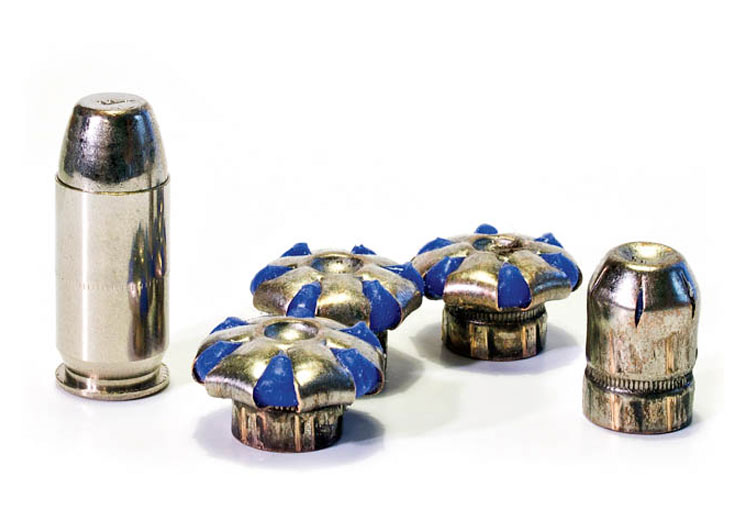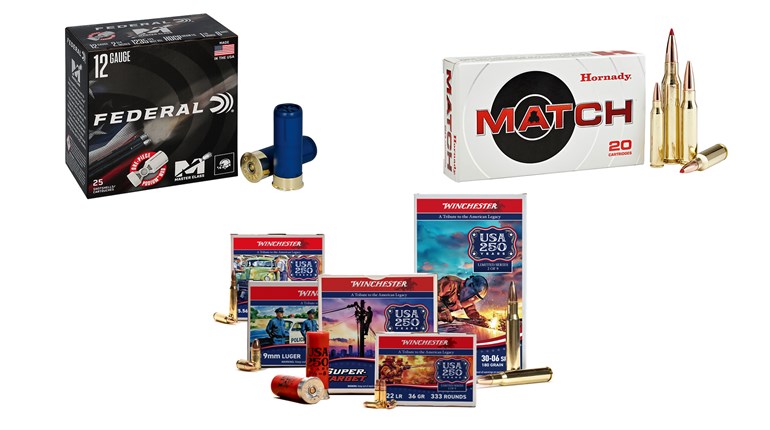
 Start up my driveway, and you'll hear barking before you reach the top. It's consoling for me to know there's 100 pounds of sharp teeth and muscle protecting my family from bad things that might be lurking around the neighborhood when I'm gone. Ultimately, you'll come face to face with a flop-eared German shepherd that will greet you with a toothy smile if you try to approach the house from any other direction, too. A good guard dog equals protection, which is probably why Federal chose that name for its new line of defensive-handgun ammunition.
Start up my driveway, and you'll hear barking before you reach the top. It's consoling for me to know there's 100 pounds of sharp teeth and muscle protecting my family from bad things that might be lurking around the neighborhood when I'm gone. Ultimately, you'll come face to face with a flop-eared German shepherd that will greet you with a toothy smile if you try to approach the house from any other direction, too. A good guard dog equals protection, which is probably why Federal chose that name for its new line of defensive-handgun ammunition.
The bullets used in Guard Dog ammunition were conceptualized in the early 1980s by Tom Burczynski, but were not introduced by Federal until about the turn of the century. They're called EFMJ (Expanding Full Metal Jacket) or CSP (Captive Soft Point) bullets. Burczynski, an independent bullet engineer, is regarded as one of the most accomplished in the industry—the Hydra-Shok, Starfire and Quik-Shok bullets were also his creations.
The initial goal of the EFMJ bullet was to provide a non-hollow-point projectile that would reliably expand without hydraulic dependence, yet would feed unfailingly in semi-automatic handguns. You see, conventional hollow-point handgun bullets need to impact a fluid-based material to expand. Bad guys are made of mostly water. As a conventional hollow point enters a bad guy, liquefied materials enter the hollow-point cavity and create pressure on the inside of the jacket walls. This forces the bullet to expand.
If the hollow-point cavity is clogged with some sort of material like cloth or dry wall, the bullet may not expand. EFMJ bullet expansion relies on mechanical force as opposed to hydraulic force. How does this work? The EFMJ bullet consists of a gilding-metal jacket surrounding a lead core located at the rear of the bullet. The open (rear) end of the jacket is crimped over the rear of the lead core, just like in a hardball round. The real difference is at the front of the bullet, where there is a void between the front of the lead core and the nose of the jacket.
This void is filled with a rubber ball Federal calls an internal polymer. The nose of the bullet is scored along its sides, surrounding the ball. When the bullet impacts something, the scores in the jacket separate, and the flat nose of the bullet compresses the ball. In a way, it's kind of like squashing an empty soda can, except a soda can collapses on itself. With the EFMJ bullet, the rubber ball forces the jacket material outward to create a wide frontal diameter.
The upside is the EFMJ bullet has no hollow-point cavity to clog up. Due to the nature of this design, wide expansion is possible with rather light bullets driven at moderately high velocities. This minimizes recoil and helps with your ability to deliver fast and accurate follow-up shots. As long as the EFMJ bullet impacts with enough velocity, it will expand regardless of what it hits.
Originally, the EFMJ was thought of as a bullet for European countries, where hollow-point bullets are not permitted. But after word got out, American law enforcement agencies wanted it, too. This led Federal to offer LE ammunition loaded with EFMJ bullets in 9 mm, .40 S&W and .45 ACP. The company also offered EFMJ bullets for these same cartridges in its Personal Defense line of ammunition. The difference: LE ammo is loaded with heavier bullets for deeper penetration.
Purely as conjecture on my part, I suspect Federal renamed its Personal Defense line of EFMJ loads Guard Dog to attract attention to a bullet design largely misunderstood by civilians. EFMJ just doesn't have a catchy ring to it like Hydra-Shok, Silvertip or even jacketed hollow point. In addition to the new name, Federal also applies a nickel coating to the EFMJ bullets and cartridge cases used for Guard Dog ammo. (I'll leave the silver bullet/werewolf jokes to someone else.) In addition, the company uses a blue internal polymer ball as opposed to the white ball employed in LE and previously offered EFMJ loads. Whether you agree with Federal's marketing strategy or not, EFMJ bullet technology works.
Using handguns with short and long barrels, I tested Guard Dog ammunition in bare gelatin and gelatin covered with four layers of polyester, which offers more resistance to bullets than commonly used denim. The most interesting discovery was if Guard Dog bullets impact with enough velocity to initiate mechanical expansion, the expansion was always the same, regardless of the cloth barrier. This is the advantage of mechanical expansion over hydraulic expansion.
With the short-barrel 9 mm and .45 ACP handguns, the four layers of polyester slowed the Guard Dog EFMJ bullet enough to prevent expansion. This was not all that surprising or uncommon; bullets from these compact handguns are at a 200-fps disadvantage. Conversely, when fired into the cloth-covered gel blocks from the 5-inch handguns, terminal performance was almost indistinguishable from that in the bare gelatin blocks.
Federal's entire line of Guard Dog ammunition looks to be practical self-defense ammunition. Functioning was flawless in the five handguns tested and when fired from handguns with 4- to 5-inch barrels, the mechanically driven deformation ensured bullets would expand even after passing through tough, heavy clothing. To some extent, over-penetration concerns are limited as well, due to the wide expansion and light bullets. As we like to say here in the hills: This dog will hunt!
Don't miss a moment of the action. Subscribe to Shooting Illustrated today!






































